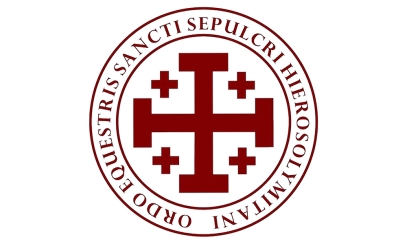
‘Truth, Justice, and Mercy’
Bishop Raica Celebrates the Annual Red Mass
Bishop Raica Celebrates the Annual Red Mass
On Oct. 21, Bishop Steven Raica celebrated the annual Red Mass, hosted by the diocese and the St. Thomas More Society, at the Cathedral of St. Paul, which was followed by a dinner. The Mass of the Holy Spirit is celebrated annually at the beginning of the judicial year to invoke divine guidance for all who seek and administer justice. The full text of bishop’s homily follows herein.
On Oct. 21, Bishop Steven Raica celebrated the annual Red Mass, hosted by the diocese and the St. Thomas More Society, at the Cathedral of St. Paul, which was followed by a dinner. The Mass of the Holy Spirit is celebrated annually at the beginning of the judicial year to invoke divine guidance for all who seek and administer justice. The full text of bishop’s homily follows herein.
Dear sisters and brothers,
It is a great joy for me to join you for this year’s edition of the Red Mass. In a particular way, I welcome to our St. Paul Cathedral community this evening all lawyers, administrators of justice, judges, those involved in the legal profession as paralegals, representatives of the justice departments, law students, and other public officials. I also extend a welcome to family, friends, and parishioners from far and wide who are here to pray for our public officials as well as the equitable and fair exercise of their competencies here in the State of Alabama and in our nation.
The Red Mass, as you know well, has legendary historic roots to pray for an outpouring of the Holy Spirit. The color red is the color of fire and a symbol of the Holy Spirit. May we implore the divine assistance in exercising our duties, so that with our cooperation, the face of the earth may be renewed through truth, justice, and mercy.
The Red Mass is a keen reminder that “justice has to do with something sacred and that those who practice its administration are at the service of something larger and greater than themselves.”
This evening, we are reminded of the larger components of our mission: to ensure that the administration of justice is accomplished with fairness, equity, and mercy, taking into account not only the requirements of the law, but the human condition of those who appear before us.
One of my earliest memories as a youngster growing up in Michigan’s Upper Peninsula, was our town courthouse. The stately silver-domed, red courthouse was situated at the head of the main north-south street. My home parish on the northwest corner, and the main school building on southeast corner. Interestingly, what captured our attention as youngsters was the statue atop the dome. It depicted Lady Justice. As you know, the woman was blindfolded, carrying a balance in one hand and a sword in the other.
The balance or scales represents the weight of the facts, proofs and arguments proposed by the parties or their advocates. Indeed, the proofs are weighed over and against the claims made so that one can arrive at a moral certitude to make a judgement according to the metrics of jurisprudence – one that reflects justice, truth, and equity.
The sword represents that justice should be swift and final. A well-known axiom of law is that “justice delayed is justice denied.”
The blindfold represents that justice should be meted with impartiality – the ideal that justice would be applied without consideration of status, wealth, power, or other factors. It was to connote fairness and equity in the decisions and sentences rendered.
Here was a symbol that was a reminder to those in my village of the dynamic of how to settle grievances and prosecute criminal offences. It is an expectation that courts operate in a way that instills credibility and authenticity in their deliberations as it strives to arrive at the truth of the question before it.
In the Book of Exodus, chapter 18, after getting burdened by rendering judgments to many people who waited in line all day, Moses’ father-in-law suggested that he appoint “trustworthy men who hate dishonest gain,” and set them over groups of thousands, hundreds, fifties and of tens. They judged the ordinary cases while the more difficult ones were referred to Moses. Already in the Old Testament, there was judicial organization emerging.
Similarly, in the Book of Deuteronomy, chapter 1, noting the growing number of people seeking their rights, Moses complained, “But how can I alone bear the crushing burden that you are, along with your bickering?” He echoes these sentiments asking that the various tribes appoint wise and experienced men as leaders charging them, “Listen to complaints among your kinsmen and administer true justice to both parties even if one of them is an alien.” “Give ear to the lowly and to great alike, fearing no man, for judgment is God’s. Refer to me any case that is too hard for you and I will hear it.” Already early on, a sense that everyone is equal before the law is emerging, but a hierarchical ordering of cases in various instances is already in place in early societies.
Already, wherever two or three are gathered, a process is emerging to listen, apply principles of justice, and seek the truth before wise and trustworthy men, so that through the equitable administration of justice, peace will prevail in the community.
The work of justice is not always easy. Some cases are simple and straightforward, while others, as we know, are quite complex. For that reason, wisdom, understanding, and counsel – gifts from the Holy Spirit – are rightly sought and relied upon to provide a fair and equitable outcome after weighing all the factors.
Another element that informs the sacred responsibility of justice and public service is the spirit of mercy and fraternity. A few weeks ago, Archbishop Gabriele Caccia, the Holy See’s permanent observer to the United Nations, noted: “Justice without fraternity is cold, blind, and minimalistic. Justice infused by fraternity, on the other hand, never remains an abstract application of norms to situations; rather, it is transformed into an attentive application of laws to persons we care about.” He added, “Fraternity is what makes it possible for justice to be perfected by mercy for all involved, since the restoration of justice is always ultimately the resolution of a ‘family dispute,’ considering we are all members of the same human family.”
Perhaps, this is what Moses was referring to when he wanted “wise,” “trustworthy,” and above all “experienced” men in that early community to render judgements. Or the depiction of Lady Justice who symbolized fairness, efficiency, and equality before the law.
Justice, rightly tempered by mercy, helps us to take into account the human condition, especially as we seek to find the right balance to acknowledge the truth of a situation and find the right remedy. Jesus often challenged the upright religious leaders of His day by criticizing their hardness of heart by not taking into account the various factors of the nature of law and when its burdens should be eased. Quite rightly, as the archbishop pointed out in his reflection, “There is a logos, a reason, a logic built into us and into all of reality that is at the basis of justice.…[I]f we do not place ourselves before God … there is the risk to ‘use’ even God for our own ends instead of serving Him…” It is necessary to practice our vocation “with an openness to understand what is God’s plan.” Drawing near to God helps us to draw near to His justice, in whose service we provide for the vindication of rights, the determination of the status of persons, or the pursuit of the common good with a fairness, equity, and mercy that emulates the very action of God which we, in turn, would expect for ourselves.
My dear friends, you participate in something truly noble and good for the benefit of all of society. I am very pleased and honored to be with you today. Through this Red Mass, we rely on the Holy Spirit to guide us in the exercise of our vocation to serve the greater community through the recognition that we are brothers and sisters all – part of one unique family of God which journeys toward Him.
May God bless you.



